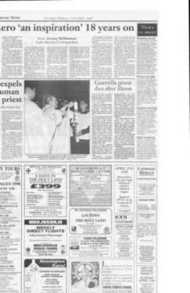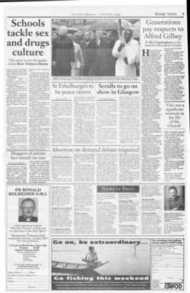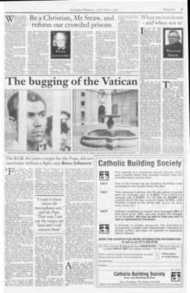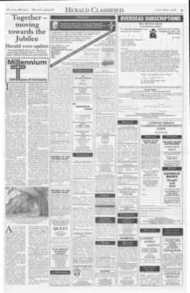Page 5, 17th April 1998
Page 5

Report an error
Noticed an error on this page?If you've noticed an error in this article please click here to report it.
Tags
Share
Related articles
The Vatican's New Prime Minister
Cardinal Who Makes Very Few Mistakes
Cold War Cardinal Dies At 83
`archive Mouse' To Papal Right-hand Man
How The Kremlin Smeared Pius Xii
The KGB, for years a target for the Pope, did not surrender without a fight, says Bruce Johnston
OR HEAVEN'S sake," gasped Sister Anna, who for 20 years assisted Cardinal Casaroli, the Vatican's former Secretary of State. 'It's all an invention. This nephew! Who has ever heard of him?"
She was reacting to a report that the KGB had not only plotted against the Pope, but had also used an electronic bug to spy on the Secretary of State in his Vatican home. It was said to have been planted a glamorous Czech woman, dubbed by the Italian press as the Vatican Mata Hari, and the wife of a mysterious nephew of the Cardinal. Sr Anna's reaction was the first to trickle out from the prelate's inner circle last week.
She may not have been the Cardinal's most important collaborator, but her remarks presaged the future official Vatican line. The next day, the Holy See's Spokesman, Dr Joaquin Navarro Valls, scoffed: "This story is so singular that it does not merit even so much as a denial." But there are Vatican denials and Vatican denials...
• , Despite such indignation, the story is not merely the product of the usual rumour-mill. It concerned the revelation that the Kremlin used a bug which was hidden in a religious statue to eavesdrop on the Cardinal's private conversations for almost a decade.
Incredible though it may seem, it forms part of an official Italian intelligence report, details of which have now emerged being among documents forming part of the third trial of Mehmet Ali Agca, the Turkish terrorist who wounded the Pope in a 1981 assassination attempt, thought to have been part of a plot with an "Eastern" connection.
According to Judge Rosario Priore, KGB involvement in the Agca plot seems "credible". And he knowingly added: "Nor am I the only one to think this." He said that Vatican collaboration in Italy's attempts to get of the bottom of the assassination attempt had been "minimal, or even nil," and as a result, investigations had been "impeded" for 17 years.
The revelation that the KGB both plotted and spied against the Vatican is contained in a 1990 memo to the then Prime Minister Giulio Andreotti from Cesis, the agency co-ordinating Italy's
intelligence organisations. Mr Andreotti is supposed to have then passed on the information to Cardinal Casaroli.
The memo said that the KGB hatched a plan against his papacy almost as soon as Polish-born Pope John Paul H ascended the throne in
October 1978. Its purpose was to discredit with "actions of disinformation and provocation, the Catholic Church and even the Pontiff himself, whose physical elimination was envisaged, if considered necessary".
The memo went on to say that the KGB had managed to eavesdrop on Cardinal Casaroli's private conversations for years thanks to a bug planted in his home by a Czech agent. The agent, Irene Trollerova, was married to Marco Torretta, whom the memo said was a nephew of the Cardinal's, and who had himself been
"an external agent of the same service the KGB] since the 1950s". Thanks to her "family" position, in the early 1980s Irene Trollerova planting a bug in a statue thought to be a religious one which was in a glass case in the dining room of the Cardinal's apartments. In April 1989, she substituted the bug with another, which she hid in a wardrobe. It functioned until it was discovered in May 1990.
According to Admiral Fulvio Martini, the head of Sismi, Italy's military intelligence service, Cesis obtained the information from Czech sources in exchange for money.
"This was in the period when Italian intelligence was concerned with Vatican security," says Admiral Martini. "We knew that during the years of the Soviet empire, the prime target for agents from East European Catholic countries Poland, Hungary, Czechoslovakia was the Vatican.
"Nor should we forget that the windows of Cardinal Casaroli's quarters face Villa Abamelec, the site of the Soviet Embassy. This means that a receiving antenna would be able to work extremely well." In an informed report which attempted to get to the bottom of the mystery, Marco Politi, the doyen of Vatican-watchers among Italian journalists, quoted collaborators of Cardinal Casaroli saying that the prelate had no nephew by the name of Marco Torretta.
The Holy See's Spokesman said the same. Pressed by Politi, he would not deny that electronic eavesdropping devices had been found in the Vatican. "I can only say," said Mr Navarro Valls, "that Cesis never sent information to the Vatican concerning this matter."
But Judge Priore said: "At the time when our investigations ended, the people mentioned in the report had been gone from Vatican City for some years."
Politi, who with journalist Carl Bernstein wrote the book His Holiness, which claimed that many in the Vatican including Cardinal Casaroli believed the assassination attempt was Soviet-ordered, now claims that the Pope had been "spied on for 50 years".
Politi also quoted Cardinal Deskur recalling that during the Cold War, "the conviction was widely shared within the Vatican that the Holy See was being spied on by the Russians in their embassy across the way on the other side of a narrow valley".
Judge Priore says he believed the relevance of the KGB episode was one of "importance" in the context of the papal assassination attempt and could help to explain the conviction that certain Vatican conversations had been overheard by anonymous telephone callers to the Holy See in 1983.
The calls concerned Emanuela Orlandi, the daughter of an employee who disappeared on 22 June 1983. Emanuela, who was never found, is thought to have been kidnapped, possibly in connection with the KGB plot. Some details mentioned by callers had apparently only been raised in private conversations between Cardinal Casaroli and another high-ranking prelate.
CCORD1NG CO his friend Cardinal Andrzej Deskur, when Karol Wojtyla, then chbishop of Krakow, was told that a visit to Poland in 1977 by a US prelate would mean that "all the microphones of the Russian and Polish secret services will be focussed on your residence," he said: "I want to know where these microphones are. In the dining room? In the library?
"That way I can go there and say the rosary out loud. And I will convert them."
blog comments powered by Disqus











